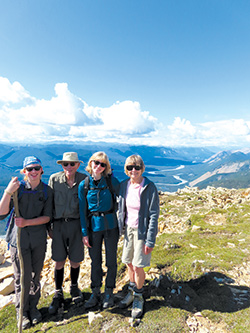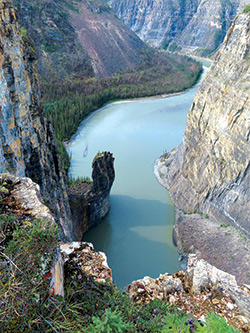The Nahanni Revisited After Nine Years of Graceful Aging

One of the greatest of our northern rivers is the South Nahanni in the Northwest Territories, and I have experienced it twice. Both my trips were wonderful, but the second was also a rude awakening.
We crossed a scree slope and ascended the steep trail toward the summit of Sunblood Mountain. We were in the Nahanni National Park Reserve, but the trail was rough. Spectacular views rewarded us, however, as we toiled upwards. Finally, we reached the summit, far above the Nahanni which snaked out of sight through blue-green mountain ranges.
Sunblood Mountain seemed much higher than nine years ago when I made the same trek. The elevation gain was formidable at about 1,000 metres, but why had it seemed so much higher this time? I concluded the answer was aging. Most body functions diminish after age 30, and my strength was no exception. The steep trail down was also demanding. I was the oldest of our group and the last to arrive at the riverbank where a canoe took me back across the river only a few hundred metres upstream from thundering Virginia Falls.

The next day we rafted through colourful Fourth Canyon in the sunshine but then were challenged by cold rainy weather. I had not packed enough clothes in my day bag, and the north is not kind to those who are unprepared. I was grateful when the guides opened our main packs so those who had underestimated the weather could put on more clothes.
We camped at The Gate and made the spectacular ascent to the top of the cliffs above the river. The climb had been steep, and it became obvious that I had sprained my right calf on Sunblood Mountain. I was the last of our party to cross the tumultuous creek near our camp on the
way back.
We paddled through the towering Gate of the Nahanni and, after a beautiful morning between the soaring walls of Third Canyon, stopped at The Library for lunch. Stacks of short horizontal rock strata reminded R. M. Patterson, who came this way in the 1920s, of books in a library, and the name stuck.
In Painted Rocks Canyon, we hiked to a fossil-laden cliff. My wife Ruth was not wearing waterproof footwear and my large grandson piggy-backed her through the creeks. On the way back, I carried her over the last creek. She is quite petite, but as I hoisted us up the steep bank, I felt a sudden pain in my calf. I had not been kind to my calf sprain.
Good weather continued as we rafted through Second Canyon and Deadmen Valley, where the beheaded bodies of the McLeod brothers were found in 1908. Then we stopped at a campsite so beautiful the guides had named it “Five-Star.” If we approached the beaver pond behind camp, there would be a resounding tail slap as the beavers dived for cover.

The next day the incredible walls of First Canyon dwarfed our rafts. At Whitespray Springs, water so pure the guides did not treat it gushed into the river with tremendous force.
We hiked up Lafferty Canyon as far as possible, donned bathing suits, and swam through several pristine pools. They seemed much colder than nine years before, and I began to shiver violently. Fortunately, warm clothes soon restored my elderly body. The next morning, we braved Lafferty’s Riffle and soaked in Kraus’s Hot Springs. As we passed through The Splits, we saw bison, and a wolverine ran along the rocky shore until it spotted us and disappeared.
Miraculously, even though Yellowknife five hundred kilometres to the east had been evacuated because of forest fires, it was still smoke-free and sunny when a Twin Otter landed on the river at Nahanni Butte to fly us out.
It had been a remarkable journey. However, the Nahanni Valley, almost timeless by our standards, had demonstrated that humans live on a very different time scale. My 78th birthday was a month away, and I was reminded how much I had aged in the nine years since my previous trip.

Werner Becker is professor emeritus at the University of Calgary and author of Rafting the Great Northern Rivers. He lives with his wife and travel companion, Ruth, in Calgary.